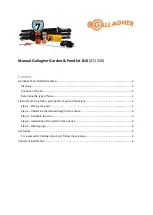
42
FAQS
Q1
How do I adjust the pressure of the heated lid for my tubes or plates?
A1
No adjustment is necessary. The lid automatically applies the correct pressure. Ensure
that all consumables used in the block are of the same height.
Q2
Do I need a different block for fully skirted plates?
A2
No. The TC-PLUS 96-well block will accommodate fully skirted as well as half-skirted and
non-skirted PCR plates.
Q3
What is “Sample Cooling”?
A3
Sample cooling can be applied during the lid pre-heat phase. This maintains the block at
4ºC while the lid is heating to temperature and avoids any increase in sample temperature
due to the heated lid before the thermal cycling program begins.
Q4
How does TERS
®
work?
A4
TERS
®
harnesses the heat released during the cooling phase for use in the next heating
phase.
By switching the fans off for a very short time at the end of the cooling period the
heat is not removed from the heat sink, but is instead stored as heat energy. Heat is
therefore available as soon as the Peltiers switch from cooling to heating. This results in
faster heating, requires less energy to heat the block and subsequently costs less to run.
Q5
What is "Hot start"?
A5
The Hot Start step is used to pause the machine at a specific temperature, typically
around 70°C, after the initial template denaturation. The reason is to allow the manual
addition of unmodified
Taq
DNA polymerase which may loose activity if added during the
initial denaturation step. Heat-activated
Taq
or Hot Start enzymes do not require this step.
Q6
What is the incremented time and temperature function for?
A6
Incremented/decremented time and temperature are used to increase or decrease either
the time or temperature incrementally over the number of cycles in a stage.
Incrementation of extension time is used with 'Long PCR' which is when large template
fragments are to be amplified (e.g. 27kb lambda DNA, 40kb genomic DNA). Decremented
temperature is used for protocols such as 'Touchdown PCR' where the first cycle starts
with a high annealing temperature and over the number of cycles in the stage there is a
gradual decrease in the temperature. This ensures that only the specific product is
amplified.
Q7
What is a gradient thermal cycler?
A7
Gradient blocks enable a particular temperature step in a protocol to be programmed so
that the temperature varies across the block. By specifying a temperature and the gradient
to be applied, each column will achieve a different temperature. The set temperature is in
the middle of the block, the lowest on the left and the highest on the right. The gradient is
the total difference across the block, for example if the set temperature was 60°C and the
gradient 10°C then the temperatures would range from approximately 55°C to 65°C from
left to right.
Q8
Why is a temperature gradient required?
A8
The annealing temperature of the specific primers used in DNA amplification often
requires optimisation. Instead of running multiple experiments with different annealing
temperatures the gradient thermal cycler allows the testing of up to 12 different annealing
temperatures simultaneously.
Содержание TC-PLUS
Страница 1: ...TC PLUS Satellite and Techne Workbench PC Software OPERATOR S MANUAL Version 1 3 11 10...
Страница 2: ...2...





































